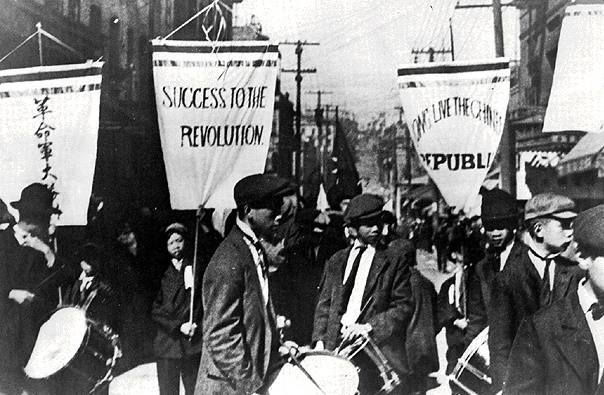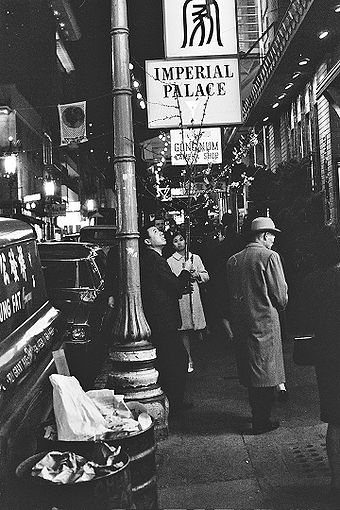Chinese Nationalism: Difference between revisions
m (1 revision(s)) |
(upgraded video code and added Chuck Gould photo) |
||
| (5 intermediate revisions by 2 users not shown) | |||
| Line 1: | Line 1: | ||
'''<font face = Papyrus> <font color = maroon> <font size = 4>Historical Essay</font></font> </font>''' | |||
''by Anthony W. Lee'' | |||
[[Image:chinatwn$nationalist-supporters-1910s.jpg]] | [[Image:chinatwn$nationalist-supporters-1910s.jpg]] | ||
'''Nationalist Demonstration in Chinatown, c. 1911''' | '''Nationalist Demonstration in Chinatown, c. 1911''' | ||
''Photo: California State Library'' | |||
Between 1906 and 1917 Chinatown regularly served as a founding point for larger nationalist and reformist political agendas on the Chinese mainland. In San Francisco in 1910, the revolutionary Sun Yat-sen established the radical T'ung Meng Hui, the forerunner to the Chinese Nationalist Party. In the city, he founded the ''Young China Daily'', which along with three other Chinatown newspapers served as an exiled journalistic organ advocating the overthrow of the Manchus. A politicized population in half-exile--that is what Chinatown often meant. | Between 1906 and 1917 Chinatown regularly served as a founding point for larger nationalist and reformist political agendas on the Chinese mainland. In San Francisco in 1910, the revolutionary Sun Yat-sen established the radical T'ung Meng Hui, the forerunner to the Chinese Nationalist Party. In the city, he founded the ''Young China Daily'', which along with three other Chinatown newspapers served as an exiled journalistic organ advocating the overthrow of the Manchus. A politicized population in half-exile--that is what Chinatown often meant. | ||
<iframe src="https://archive.org/embed/4012_Gould_Can_5385-4_Parade_Celebrating_Chinese_Republic" width="640" height="480" frameborder="0" webkitallowfullscreen="true" mozallowfullscreen="true" allowfullscreen></iframe> | |||
'''Chinese in San Francisco celebrate the founding of the Chinese Republic, 1912.''' | |||
''Video: [http://www.archive.org/details/prelinger Prelinger Archive]'' | |||
The consistent undercurrent of political activity is an important subtext to the redevelopment of Chinatown. In an odd confluence, political dissent was nurtured within the increasingly consumer-friendly tourist quarter. We must remember that the 1911 October Revolution, which effectively ended three hundred years of Manchu rule in China, was almost completely financed by overseas Chinese; that is, those same tourist shops and tuxedoed merchants helped to fund an entire overthrow. No wonder that Chinatown's immigrant men happily cut off their queues at word of Sun Yat-sen's success, since they felt they had done much to bring it about from a distance. | The consistent undercurrent of political activity is an important subtext to the redevelopment of Chinatown. In an odd confluence, political dissent was nurtured within the increasingly consumer-friendly tourist quarter. We must remember that the 1911 October Revolution, which effectively ended three hundred years of Manchu rule in China, was almost completely financed by overseas Chinese; that is, those same tourist shops and tuxedoed merchants helped to fund an entire overthrow. No wonder that Chinatown's immigrant men happily cut off their queues at word of Sun Yat-sen's success, since they felt they had done much to bring it about from a distance. | ||
| Line 9: | Line 21: | ||
With Glitter Chinatown, we are faced with the possibility that a founding opposition in radical behavior, between an embrace of activist politics and an embrace of a tourist industry, was at one time not held to be so reducible. Young, radicalized Chinese men attempted to include, rather than repress or discard, the products and desires of the American commodity fetish. | With Glitter Chinatown, we are faced with the possibility that a founding opposition in radical behavior, between an embrace of activist politics and an embrace of a tourist industry, was at one time not held to be so reducible. Young, radicalized Chinese men attempted to include, rather than repress or discard, the products and desires of the American commodity fetish. | ||
In the case of young, immigrant men, the spectacle of Chinatown, with its precious porcelains, silk brocades, asphalt streets, and electric lamps, was a space still in the making. The self-conscious fabrication of a consumerized ethnic subculture was a way of ''elaborating'' a nationalist political stance. Categorizing, displaying, and selling the industrialized kitsch products of the Chinese was the means by which to articulate a nationalist identity ''from a distance''. | [[Image:Chinatown-new-years 0941 Chuck-Gould.jpg|340px|left|thumb|'''Chinatown New Years c. 1965'''; ''photo: © Chuck Gould, all rights reserved]] In the case of young, immigrant men, the spectacle of Chinatown, with its precious porcelains, silk brocades, asphalt streets, and electric lamps, was a space still in the making. The self-conscious fabrication of a consumerized ethnic subculture was a way of ''elaborating'' a nationalist political stance. Categorizing, displaying, and selling the industrialized kitsch products of the Chinese was the means by which to articulate a nationalist identity ''from a distance''. | ||
"Dr. Sun had told us that our main job in America was to raise funds," a young revolutionary once observed (Nee and Nee 1972, 74). To fight, he became a dry goods clerk, peddling Chinese goods to the quarter's new visitors. In the early development of touristic Chinatown, the collected objects and colorful environment inspired a collective wish-image for a nation-state. | "Dr. Sun had told us that our main job in America was to raise funds," a young revolutionary once observed (Nee and Nee 1972, 74). To fight, he became a dry goods clerk, peddling Chinese goods to the quarter's new visitors. In the early development of touristic Chinatown, the collected objects and colorful environment inspired a collective wish-image for a nation-state. | ||
''excerpted from ''Reclaiming San Francisco: History, Politics, Culture, ''A City Lights Anthology, 1998.'' | |||
[[19th Century Medical Self-Help, Part II | Prev. Document]] [[The Glittering Ghetto Revisited | Next Document]] | |||
[[ | [[category:Chinatown]] [[category:Chinese]] [[category:1910s]] | ||
Latest revision as of 10:55, 6 April 2014
Historical Essay
by Anthony W. Lee
Nationalist Demonstration in Chinatown, c. 1911
Photo: California State Library
Between 1906 and 1917 Chinatown regularly served as a founding point for larger nationalist and reformist political agendas on the Chinese mainland. In San Francisco in 1910, the revolutionary Sun Yat-sen established the radical T'ung Meng Hui, the forerunner to the Chinese Nationalist Party. In the city, he founded the Young China Daily, which along with three other Chinatown newspapers served as an exiled journalistic organ advocating the overthrow of the Manchus. A politicized population in half-exile--that is what Chinatown often meant.
<iframe src="https://archive.org/embed/4012_Gould_Can_5385-4_Parade_Celebrating_Chinese_Republic" width="640" height="480" frameborder="0" webkitallowfullscreen="true" mozallowfullscreen="true" allowfullscreen></iframe>
Chinese in San Francisco celebrate the founding of the Chinese Republic, 1912.
Video: Prelinger Archive
The consistent undercurrent of political activity is an important subtext to the redevelopment of Chinatown. In an odd confluence, political dissent was nurtured within the increasingly consumer-friendly tourist quarter. We must remember that the 1911 October Revolution, which effectively ended three hundred years of Manchu rule in China, was almost completely financed by overseas Chinese; that is, those same tourist shops and tuxedoed merchants helped to fund an entire overthrow. No wonder that Chinatown's immigrant men happily cut off their queues at word of Sun Yat-sen's success, since they felt they had done much to bring it about from a distance.
With Glitter Chinatown, we are faced with the possibility that a founding opposition in radical behavior, between an embrace of activist politics and an embrace of a tourist industry, was at one time not held to be so reducible. Young, radicalized Chinese men attempted to include, rather than repress or discard, the products and desires of the American commodity fetish.
In the case of young, immigrant men, the spectacle of Chinatown, with its precious porcelains, silk brocades, asphalt streets, and electric lamps, was a space still in the making. The self-conscious fabrication of a consumerized ethnic subculture was a way of elaborating a nationalist political stance. Categorizing, displaying, and selling the industrialized kitsch products of the Chinese was the means by which to articulate a nationalist identity from a distance.
"Dr. Sun had told us that our main job in America was to raise funds," a young revolutionary once observed (Nee and Nee 1972, 74). To fight, he became a dry goods clerk, peddling Chinese goods to the quarter's new visitors. In the early development of touristic Chinatown, the collected objects and colorful environment inspired a collective wish-image for a nation-state.
excerpted from Reclaiming San Francisco: History, Politics, Culture, A City Lights Anthology, 1998.


